Overview
Due to an extreme shortage of medically approved and commercially available personal protective equipment (PPE), WHO and CDC previously recommended that only sick or those caring for sick should wear a mask. They have recently changed guidance. Many experts advocate for public mask use as well as governments.
We provide here a curated list of DIY masks along with links to build pages. We have ranked each design along five dimensions, with 5 stars the best. Less tools and materials are considered better. In some cases a design may call for more materials or tools, but if these are commonly available we will give it a higher rating than a design that has fewer highly specialize tools. Protection is judged on the combination of face seal and filter efficiency and, in some cases, full face protection (for example if a mask is integrated into a face shield).
If you have a design and would like it to be included in this list, please leave a comment below and provide a link to your build page. There is no ‘best’ design because everybody has different materials, tools, skills, time, etc. Only limited designs are acceptable for front line workers or healthy caring for the sick. Many designs are acceptable for use by healthy people in public. In this case we encourage you to learn about the principle of good mask design and get creative!
Skip To Section:
1. Filter Materials for DIY Masks
1. Assembling and Using a DIY Mask
U of Florida Health’s Halyard H600 Sewn Masks, Prototypes 1 & 2

University of Florida Health’s Halyard H600 Sewn Mask
| Dimension | Rank | Comments |
|---|---|---|
| Tools | ★★★ | Sewing Machine, scissors, ruler, pins or clips,jewlry pliers,ink pen, elastic bands or ties |
| Materials | ★ | Halyard H600 two-ply spun polypropylene, wire, acrylic yarn |
| Comfort | ★★★★★ | soft fabric against face, tie around head |
| Protection | ★★★★★ | Halyard tested to 3.0 microns (same as surgical mask) but may be better, good seal around nose with wire insert. Passed the Respirator Fit Test |
| Reuse/Disinfection | ★★★★ | Do not wash. If reused it is advised to use one of the standard CDC N95 mask reuse protocols, i.e. bake at 70C for 30min. Good info here |
Healthcare worker review and build tutorial including fit-test youtube video
U of F filed a patent, but appear to be OK with people making the mask. Specialized Halyard H600 material only found in hospitals but is potentially abundant. Important Note: Their initial claims of “better than N-95” were based on manufacture marketing material related to blocking of bacteria:
“It blocks 99.9% of particulates, making the masks about 4% more effective at blocking particulate material than the N95 masks, according to Bruce Spiess, M.D., a professor of anesthesiology in the UF College of Medicine, who made that calculation based on the manufacturer’s specifications.”
Bacterial filtration efficiency (BFE) is a measure of the effectiveness of a material to filter bacteria 3.0 µm in size, whereas filtration efficiency (FE) is a measure of the effectiveness of a material to filter submicron (median diameter of 0.075 µm) particles of NaCl. Medical masks have a BFE of >95–99% and a >78–87% FE. The N95 respirator has an FE of >95% and a BFE of >>99% [ref].
The manufacturer has released a statement on its website attempting to protect itself from potential liability.
Snorkel Mask Adapter
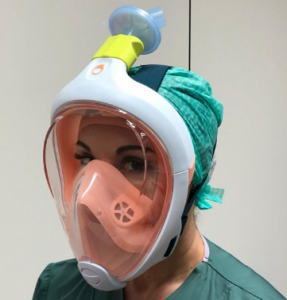
Snorkel mask filter adapter
| Dimension | Rank | Comments |
|---|---|---|
| Tools | ★★★ | 3D Printer |
| Materials | ★ | PLA Filament, specific snorkel mask, specific filter |
| Comfort | ★★★ | Soft rubber seal against face |
| Protection | ★★★★★ | Sealed full face shield and rear-facing mask filter |
| Reuse/Disinfection | ★★★ | Filter can be replaced, plastic spray-disinfected or washed with soap and water. Large/bulky. |
This mask is intended for medical staff and not for private individuals. However, if you already own a snorkel mask and can obtain or build a filter, and are not embarrassed to go out in public with it, it’s a good option. Stanford video.
Everymask mask harness
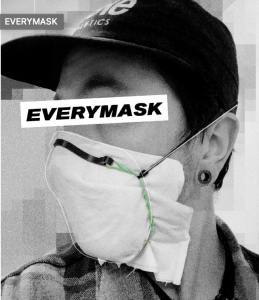
Everymask DIY Mask Harness
| Dimension | Rank | Comments |
|---|---|---|
| Tools | ★★★★ | 3D printer OR pliers with wire cutter |
| Materials | ★★★★ | 3D printer filament OR cloths hanger, (3) rubber bands, small diameter rope or elastic band, fabric |
| Comfort | ★★★★ | Cloth pressed tight to face, elastic band or rope around head |
| Protection | ★★★ | Good face seal. Fabric dependent, but would be excellent if used with a surgical mask, HEPA material or Halyard 600 |
| Reuse/Disinfection | ★★★★ | Fabric and harness can be washed |
This project is a slight upgrade to the “Fix the Mask” design below, as the wire resolves potential issues with seal around nose.
Fix the Mask DIY Surgical Mask Brace
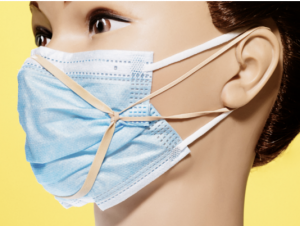
The Surgical Mask Brace
| Dimension | Rank | Comments |
|---|---|---|
| Tools | ★★★★★ | None! |
| Materials | ★★★ | Surgical Mask, (3) rubber bands |
| Comfort | ★★★ | Surgical mask pressed tight to face, rubber bands pulling ears. |
| Protection | ★★★★ | OK seal except for folds in surgical mask.ASTM surgical masks rated at 0.1 microns is ≥95%. |
| Reuse/Disinfection | ★★ | Unclear. We recommend N-95 reuse procedures, see this page for more information on possibilities. |
Note: If you have surgical masks please donate them to your local healthcare professionals and inform them of this project. Medically approved/certified masks are in very short supply and need to go to front-line workers first.
3D Printed Breathing Mask with Screw-In Filters V2

3D Printed Breathing Mask with Screw-In Filters V2
| Dimension | Rank | Comments |
|---|---|---|
| Tools | ★★ | 3D Printer, sanding paper (multiple grits), scissors/knife |
| Materials | ★★ | PLA Filament, super glue, rubber o-rings, filler, spray paint, rubber window trimming tape |
| Comfort | ★★★★ | Soft rubber seal, may not provide adequate ventilation when combined with efficient filter material |
| Protection | ★★★★ | Dependent on filter material but surgical mask material is specified |
| Reuse/Disinfection | ★★★★ | Filter can be replaced, plastic spray-disinfected or washed with soap and water. |
Involved and requires substantial time and materials but looks great.
UnityPoint Health Olsen Sewn Mask with Removable Filter

UnityPoint Olsen Face Mask
| Dimension | Rank | Comments |
|---|---|---|
| Tools | ★★★ | Sewing machine, scissors, pins |
| Materials | ★★★ | Cotton weave fabric, double-sided skin adhesive, all-purpose thread, (2) hair ties, filter material (HEPA) |
| Comfort | ★★★ | Soft fabric against face, hair-ties pulling ears. |
| Protection | ★★★★ | OK seal but no nose clamp. We recommend wearing with glasses for improved seal around nose. Multiple layers of cotton fabric with HEPA filter insert. |
| Reuse/Disinfection | ★★★★ | Mask can be washed and filter replaced. |
UnityPoint Health is asking for donations of this mask. Note they are not asking for fully finished masks, as they will add final touches and provide filter material.
RagMask
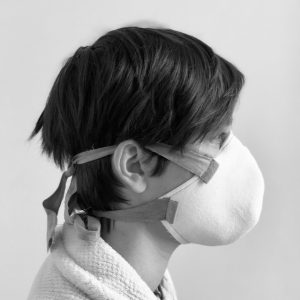
Ragmask
| Dimension | Rank | Comments |
|---|---|---|
| Tools | ★★★ | Sewing machine, scissors |
| Materials | ★★★ | fabric, filter material, 14ga or similar wire |
| Comfort | ★★★★★ | Soft fabric against face, fabric ties around head |
| Protection | ★★★ | Good seal with design and nose crimp wire, filter material in addition to fabric |
| Reuse/Disinfection | ★★★ | Filter cannot be removed but mask can be washed if filter material allows it |
Very good step-by-step instructions with pictures.
HEPA Vacuum Bag Sewn Mask

HEPA Vacuum Sewn Mask
| Dimension | Rank | Comments |
|---|---|---|
| Tools | ★★★ | Sewing machine, glue gun, scissors, pencil |
| Materials | ★★★ | HEPA vacuum bags, hot melt glue, thread, pipe cleaner, elastic bands |
| Comfort | ★★★ | vacuum bag tight around face, elastic around head. Vacuum bag can be hard to breath through due to high air resistance. |
| Protection | ★★★★ | Good seal, efficient filter material but untested for mask use. |
| Reuse/Disinfection | ★★★ | Unclear. We recommend an N-95 disinfection protocol. More information here. |
Due to possibility of materials in HEPA filters like fiberglass or other materials dangerous if inhaled, we recommend a layer of tight weave cotton on the face-side.
The Montana Mask (3D printed)
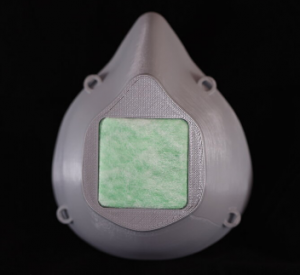
THE MONTANA MASK
| Dimension | Rank | Comments |
|---|---|---|
| Tools | ★★★ | 3D Printer, knife |
| Materials | ★★ | PLA Filament, rubber weather stripping, elastic bands, filter material |
| Comfort | ★★★★ | soft rubber against face, elastic around head. |
| Protection | ★★★★ | Dependent on filter material. Good seal. |
| Reuse/Disinfection | ★★★ | Mask can be washed, filter replaced. Weather stripping may come off during washing. |
Might want to look into Simolex mask gasket which was identified by the FiredByCorona team.
HK Mask
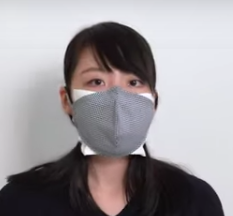
HK Mask
| Dimension | Rank | Comments |
|---|---|---|
| Tools | ★★★ | Sewing Machine, scissors, ruler, marker, pins |
| Materials | ★★★ | Fabric, thread, elastic ties or fabric ties, filter material |
| Comfort | ★★★★★ | Soft fabric worn around face. |
| Protection | ★★★★ | Dependent on fabric and filter material, but .3um filter specified. Good seal. Embedded wire for nose fit. |
| Reuse/Disinfection | ★★★★★ | Mask can be washed, filter discarded. |
Multiple patterns/sizes available with good tutorials and videos.
How to Make DIY Face Masks with Air Filters
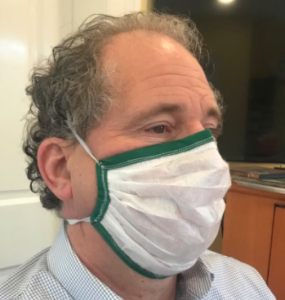
DIY mask with Air Filters
| Dimension | Rank | Comments |
|---|---|---|
| Tools | ★★★ | Sewing machine, wire clippers and/or scissors, ruler, marker, pins |
| Materials | ★★★ | MERV 12 or higher Filtrete Air Filter, Thread, 1/4″ elastic band, wire cloths hanger OR 1/2″ wide X 1/64″ thick aluminum strip (K&S precision metals), stapler, bias tape or old T-shirt cut into strips |
| Comfort | ★★★★ | Air filter worn around/close to face, cotton seal/edging. |
| Protection | ★★★★ | .3um filter specified with good nose seal. Uncertainty regarding safety of filter material if breathed in, see note below. |
| Reuse/Disinfection | ★★★ | Unclear. Tutorial states mask can be washed by hand. However, we are not aware of studies showing effectiveness of washing Filtrete air filters. We recommend following guidance related to N-95 masks . |
Tutorial warns about ensuring the filter used is not fiberglass, as this can be dangerous if inhaled. We recommend a single layer of cotton between filter material and face.
Protocol for 3D Printing Masks
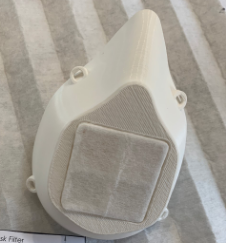
PROTOCOL FOR 3D PRINTING MASKS
| Dimension | Rank | Comments |
|---|---|---|
| Tools | ★★★ | 3D Printer, scissors |
| Materials | ★★★ | PLA Filament, filter material (HEPA Filter), elastic band or thin rope |
| Comfort | ★★ | Heat-formed PLA against face |
| Protection | ★★★★ | Dependent on cloth filter material but HEPA specified. Good seal if warn tight. Due to ridged-edge PLA may break seal while talking. |
| Reuse/Disinfection | ★★★★★ | Mask can be washed and filter replaced. |
Very details instructions with multiple size mask files and great reference material.
Simple Respiratory Mask
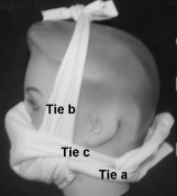
Simple Respiratory Mask
| Dimension | Rank | Comments |
|---|---|---|
| Tools | ★★★★★ | Scissors, Marker, Ruler |
| Materials | ★★★★★ | Cotton t-shirt |
| Comfort | ★★★ | Soft but dense fabric worn tight around face. Stuffy. |
| Protection | ★★★ | Dependent on cloth material and number of layers. Good seal but requires practice. |
| Reuse/Disinfection | ★★★★★ | Mask can be easily washed. |
3D Printed Face Mask
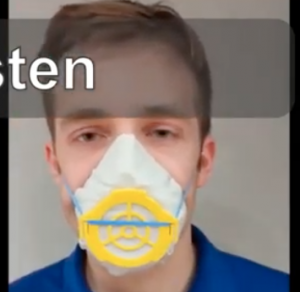
3D Printed Face Mask
| Dimension | Rank | Comments |
|---|---|---|
| Tools | ★★★ | 3D Printer, scissors |
| Materials | ★★★ | PLA Filament, cloth, large rubber band |
| Comfort | ★★ | Heat-formed PLA against face |
| Protection | ★★ | Dependent on cloth filter material. Press-fit fabric design limits filter thickness. Good seal if warn very tight. Due to ridged-edge PLA may break seal while talking. |
| Reuse/Disinfection | ★★★★★ | Mask and filter can be washed without damage. |
Simple 3D print design, minimal post-processing
Sewing Reusable Cloth Masks
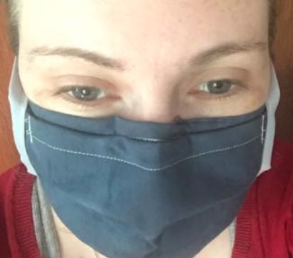
Sewing Reusable Cloth Masks
| Dimension | Rank | Comments |
|---|---|---|
| Tools | ★★★ | Sewing Machine, scissors, wire-cutters |
| Materials | ★★ | Cotton fabric, filter material, non-fusible interfacing, wire, thread |
| Comfort | ★★★★ | Soft cloth against face |
| Protection | ★★★ | Dependent on cloth and filter. Good seal. |
| Reuse/Disinfection | ★★★★★ | Mask can be washed, filter replaced |
No Sew DIY N95-ish Type Protective Face Mask
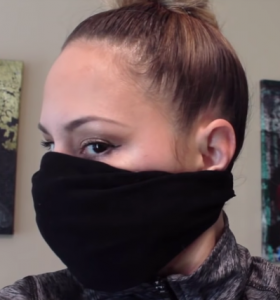
No Sew DIY N95 Type Protective Face Mask
| Dimension | Rank | Comments |
|---|---|---|
| Tools | ★★★ | Glue-gun, scissors, ruler, pen |
| Materials | ★★★ | Cotton fabric, MERV-13 Filter from furnace filter, aluminium-foil, rubber bands, maxi-pad |
| Comfort | ★★★★ | soft cloth against face, tie around head |
| Protection | ★★★ | Dependent on filter but MERV-13 specified. OK seal. |
| Reuse/Disinfection | ★ | Filter will capture particles but its glued into cloth. Re-use not recommended unless sterilized in heat for prolonged periods of time. |
Waterproof maxi-pad layer is a critical flaw, otherwise good design with limited tools. Due to potential of harmful substances (like fiberglass) in some HEPA/furnace filters, it’s a good idea to place a layer of tight weave cotton or other known-safe material between your face and the HEPA/furnace filter material.
PET Bottle Mask
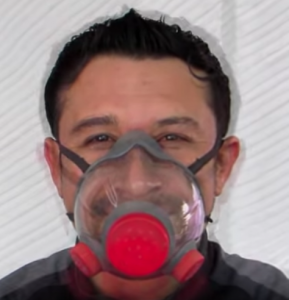
PET Bottle Mask
| Dimension | Rank | Comments |
|---|---|---|
| Tools | ★★ | Knife, pliers, box cutter, frying pan, scissors, iron, ruler |
| Materials | ★★ | (1) big PET bottle, (1) medium PET Bottle, (2) small PET bottles, filter material, contact cement, strip foam, silicon glue/sealant, marker, elastic bands |
| Comfort | ★★★ | Soft foam against face, elastic around head. |
| Protection | ★★ | Without forming plastic to face good seal is unlikely. Filer efficiency dependent on material. |
| Reuse/Disinfection | ★★ | Can be washed but foam tape may come off. |
Lots of materials and tools but mostly common and easy to come by. Instructions are in Spanish but very good visual instructions. Creative!
Another bottle respirator design requiring so many tools and materials im not going to bother listing it. This guy is having fun.
Knowm Modified Copper 3D Single-Use Mask

Finished N-95 Substitute Mask
| Dimension | Rank | Comments |
|---|---|---|
| Tools | ★★ | 3D Printer, scissors, glue gun (optional) |
| Materials | ★★ | PLA Filament, Cotton fabric, filter material, glue, elastic bands or string |
| Comfort | ★★★★ | heat-molded PLA with soft cloth against face |
| Protection | ★★★ | Dependent on cloth and filter. Good seal if properly heat-formed to face. |
| Reuse/Disinfection | ★★ | Mask can be sprayed with disinfectant and left to sit but not washed. |
Fast to print and assemble if 3D Printer bed is larger than 8.5in.
No Sew T-Shirt Mask for Men with Beards
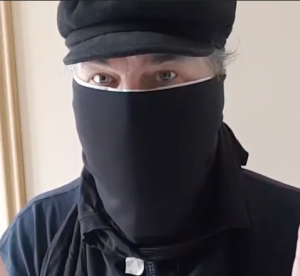
No Sew T-Shirt Mask for Men with Beards
| Dimension | Rank | Comments |
|---|---|---|
| Tools | ★★★★★ | None! |
| Materials | ★★★★★ | t-shirt, paper towels |
| Comfort | ★★★ | paper towel pressed firmly against face |
| Protection | ★★ | Poor seal around nose. Due to tight face wrap better than ‘surgical mask’ type fabric mask. |
| Reuse/Disinfection | ★★★★ | Shirt can be washed, paper towel discarded |
Addition of paper towel for moisture absorption is good idea for this design. If HEPA filter material is available, insertion between t-shirt layers combined with better nose seal would greatly increase filtration efficacy. Due to potential of harmful substances (like fiberglass) in some HEPA filters, it’s a good ideal to place a layer of cotton or other known-safe material between your face and the HEPA filter material.
No-Sew Pleated Face Mask with Handkerchief
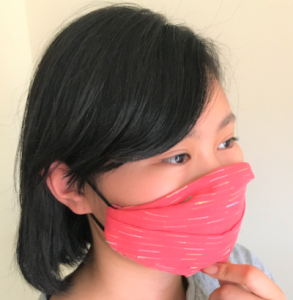
No-Sew Pleated Face Mask with Handkerchief and Hair Tie
| Dimension | Rank | Comments |
|---|---|---|
| Tools | ★★★★★ | None! |
| Materials | ★★★★ | handkerchief, Hair Tie |
| Comfort | ★★★ | soft fabric against face, elastic band pulling ears |
| Protection | ★ | Poor seal, poor filter. Better than nothing. |
| Reuse/Disinfection | ★★★★★ | Mask can be washed |
Here is good video tutorial of this design.
Fired by Corona 2.0
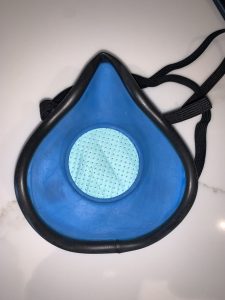
Fired By Corona 2.0 Mask
| Dimension | Rank | Comments |
|---|---|---|
| Tools | ★★★ | 3D Printer, Knife |
| Materials | ★★★ | PLA printer filament, Simolex mask gasket, rubber band, elastic strap |
| Comfort | ★★★★ | soft rubber against face, chord around head |
| Protection | ★★★★ | good seal, filter material dependent |
| Reuse/Disinfection | ★★★★ | Mask can be washed, filter discarded |
DIY Cloth Face Mask
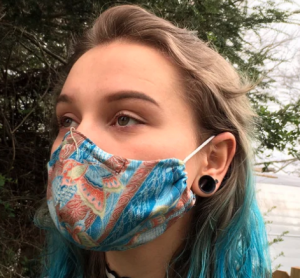
DIY Cloth Face Mask
| Dimension | Rank | Comments |
|---|---|---|
| Tools | ★★★ | Sewing machine, scissors, pliers, iron |
| Materials | ★★★ | fabric, thread, wire, elastic chord |
| Comfort | ★★★ | soft fabric against face, chord around ears |
| Protection | ★★ | OK seal, poor filter |
| Reuse/Disinfection | ★★★★★ | Mask can be washed |
Detailed but wordy build instructions.
Cut T-Shirt Mask
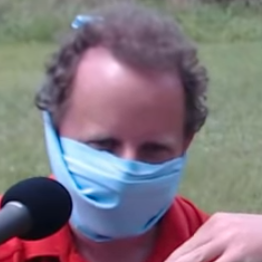
No sew cloth mask
| Dimension | Rank | Comments |
|---|---|---|
| Tools | ★★★★ | Scissors |
| Materials | ★★★ | Cotton T-Shirt, Filter material, cloths pin |
| Comfort | ★★★★ | soft fabric against face |
| Protection | ★★★ | OK seal if warn tightly, poor seal around nose if not careful. OK filter when multiple filter layers combined with shirt. |
| Reuse/Disinfection | ★★★★★ | Mask can be washed, filter material discarded |
A simplified variation of the Simple Respiratory Mask.
Paper Towel & Plastic Shield Mask
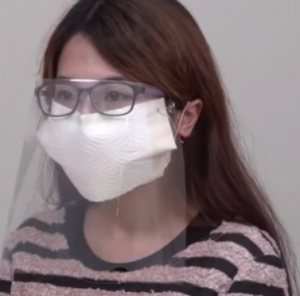
Paper Towel & Plastic Shield Mask
| Dimension | Rank | Comments |
|---|---|---|
| Tools | ★★★★ | hole puncher, scissors |
| Materials | ★★★ | Paper towels, tissue, masking tape, binder clips rubber bands, clear thin plastic, glasses |
| Comfort | ★★★★ | soft paper towl against face |
| Protection | ★★★ | poor seal and filter but combined with face-shield provides OK protection |
| Reuse/Disinfection | ★★ | Mask is discarded, plastic can be washed or sprayed |
Many materials but all common. Common tools.
Is paper towel effective at blocking viruses?
Joann’s Fabric Mask
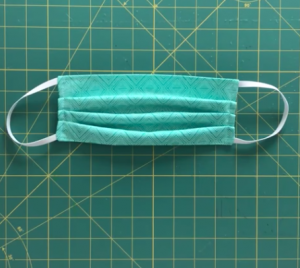
Joann’s Fabric Mask
| Dimension | Rank | Comments |
|---|---|---|
| Tools | ★★★ | sewing machine, thread, pencil, scissors, ruler |
| Materials | ★★★ | fabric, fusible interfacing, elastic bands |
| Comfort | ★★★★★ | soft fabric against face, elastic around head. |
| Protection | ★ | poor seal and filter |
| Reuse/Disinfection | ★★★★★ | Mask can be washed |
Common materials if you already sew. While these masks are not for personal protection from virus, at a population level they make a difference by preventing droplet spread.
Beth’s Fast Fabric Mask
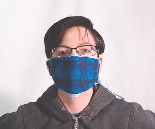
Beth Gordon Fast Fabric Mask
| Dimension | Rank | Comments |
|---|---|---|
| Tools | ★★★ | Sewing machine, scissors, ruler |
| Materials | ★★★★ | fabric, thread |
| Comfort | ★★★★★ | soft fabric against face, fabric ties around head. |
| Protection | ★ | poor seal and filter |
| Reuse/Disinfection | ★★★★★ | Mask can be washed |
A good video tutorial (to the point and clear) on how to make fabric sewn masks quickly. While these masks are not for personal protection from virus, at a population level they make a difference by preventing droplet spread.
Knowm Modified Copper 3D Respirator
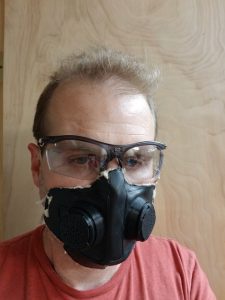
Finished respirator
| Dimension | Rank | Comments |
|---|---|---|
| Tools | ★ | 3D Printer, Soldering Iron |
| Materials | ★★★ | PLA Filament, Kitchen Towl, Elastic bands or string ties |
| Comfort | ★★★★ | soft fabric against face, elastic around head. Seal and filter makes it a bit stuffy. |
| Protection | ★★★ | Filter and cloth dependent. Good seal if properly heat-formed to face and chin ridge sealed. |
| Reuse/Disinfection | ★★★ | Mask can be washed in soap and water and left to dry |
Heat-welding requires soldering iron, which is rare tool for many. Disinfection requires leaving mask for prolonged periods to dry.
Sewn Mask for Hard of Hearing
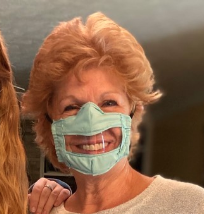
DIY mask for hard of hearing
| Dimension | Rank | Comments |
|---|---|---|
| Tools | ★★★ | Sewing machine, scissors |
| Materials | ★★★ | Thread, elastic bands, soft flexible plastic i.e. vinyl |
| Comfort | ★★★ | Soft fabric on face, elastic around head. Plastic limits ventilation. |
| Protection | ★★ | Good seal, filter is fabric dependent. Design limits ventilation or ability for removable filter inserts so protection is limited |
| Reuse/Disinfection | ★★★★ | can be washed |
No instructions or build page provided but not hard to figure out. Great mask idea for those needing to interact with individuals who are hard of hearing and need to see lips moving. “your mask protects me, my mask protects you”
DIY Bra Mask
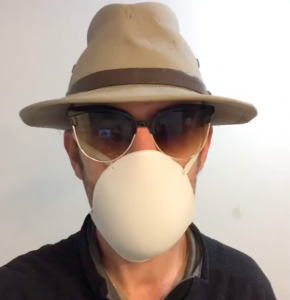
DIY Bra Face Mask
| Dimension | Rank | Comments |
|---|---|---|
| Tools | ★★★★ | Stapler |
| Materials | ★★★★ | Bra, staples, elastic bands (if not already on bra) |
| Comfort | ★★★ | Bra cup against face, elastic pulling ears |
| Protection | ★★ | Seal around nose needs improvement. Bra filtering ability uncertain. |
| Reuse/Disinfection | ★★★★ | can be washed |
Two masks per bra and comes in multiple sizes A, B, C, D! leave it to the french. Incognito sunglasses and hat recommended when wearing this.
Tissue Paper Mask
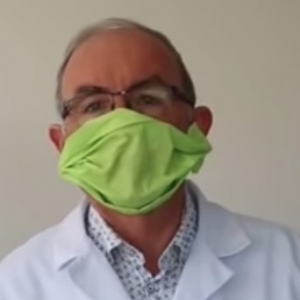
Fabriquer un masque de protection par le Pr Garin
| Dimension | Rank | Comments |
|---|---|---|
| Tools | ★★★★ | Stapler, Scissors |
| Materials | ★★★★★ | Tissue paper (napkin, paper towl, etc), staples, rubber bands |
| Comfort | ★★★ | Tissue paper on face, rubber bands around ears |
| Protection | ★ | Poor seal, Poor filter |
| Reuse/Disinfection | ★ | Cannot be re-used. |
Novice Bottle Head Gas Mask
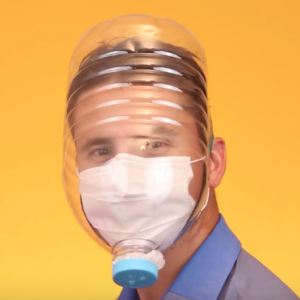
Plastic bottle full face shield and air filter
| Dimension | Rank | Comments |
|---|---|---|
| Tools | ★★★★ | Scissors |
| Materials | ★★★★ | Large clear plastic bottle, tape, filter material |
| Comfort | ★ | Hard plastic edge on neck. Head in a bottle. |
| Protection | ★★ | Poor seal but has a face shield |
| Reuse/Disinfection | ★★★ | Bottle can be washed but tape may come unstuck. |
Advanced Bottle Head Gas Mask
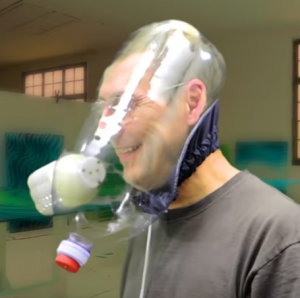
Advanced Bottle Head Gas Mask
| Dimension | Rank | Comments |
|---|---|---|
| Tools | ★ | sewing machine, sharp point, drill and drill bits, tweezers, sanding paper, marker, hole punch |
| Materials | ★ | Large clear plastic bottle, medium clear plastic bottle, (3) plastic bottle lids, (4) small machine screws with (8) nuts, cord with cord lock, elastic band (2) rubber bands, latex glove, activated carbon, fabric bag, filter material |
| Comfort | ★★★ | stiff fabric around neck, head in bottle |
| Protection | ★★★ | good seal with face shield but poor filter. Activated charcoal is good for chemical adsorption but likely not virus. |
| Reuse/Disinfection | ★★ | could be washed and filter material replaced but lots of parts to come undone. |
Did you know that creativity reduces stress?
DIY Filter Materials
What Are The Best Materials for Making DIY Masks?
Standardized Synthesis of Face Masks as a Harm Reduction Strategy in Times of PPEShortage – COVID-19
If you cannot find special-purpose filter fabric, you can still make a reasonably effective mask. You must strike a balance between high filter efficiency (keep virus out) and low pressure (keep you breathing). If you have a new hepa filter material, this is ideal. Multiple layers of dense cotton will work. Soaking the outermost layer in a concentrated salt solution and allowing to dry may increase effectiveness against virus through de-activation. (see referenced paper below)
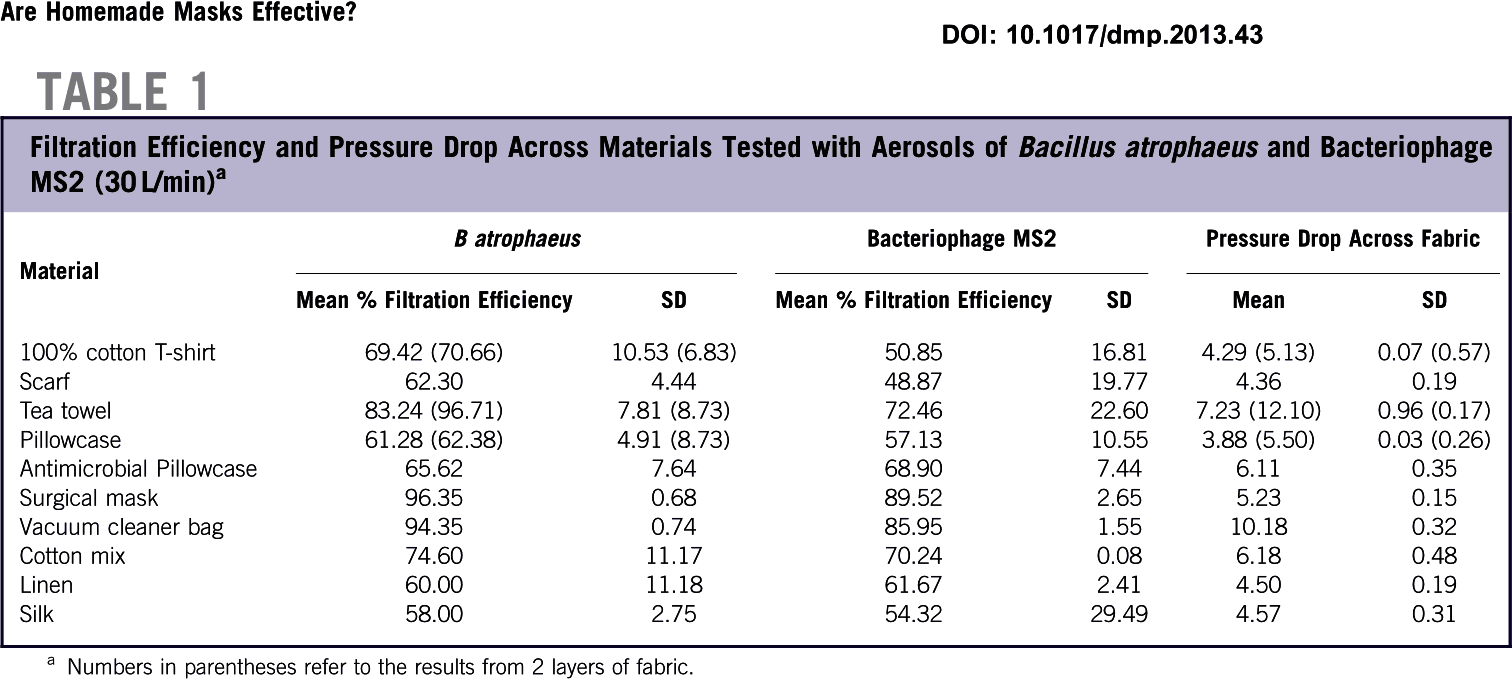
Household material effectiveness for masks
If you use, for example, a vacuum cleaner bag then it will have high efficiency at filtering particles but you may not be able to breath, provided your mask has a good seal–this renders the mask useless. Achieving high particle filtration while maintaining breathability is a hard problem without specialized materials. However, outside of a hospital setting, some protection is better than no protection.
If you are not planning on using the mask in a clinical setting or you are not in close proximity to an infected individual, you do not need to risk contracting the virus by going shopping for filter materials if you have something that is ‘good enough’ in your home already. If you are under state, county or city orders to shelter in place…don’t go shopping.
To achieve “N95 compliance”, in addition to a really good face seal, a MERV 13 or higher filter material can be used.
“Medical masks and N95 respirator are widely used to protect against airborne diseases such as tuberculosis, SARS, MERS, avian and swine flues, and the recent emerging coronavirus (COVID-19). The filtration layer of these masks is made of meltblown (MB) PP (polypropylene) nonwoven electret – electrostatically charged media”…[read more]
Assembling and Using a Mask
Thanks to Creativation over at Reddit for this thorough guidance. [go to
- Disinfect working surfaces and surfaces hands will touch.
- Ensure clean/sterile materials. Disinfect as necessary.
- Disinfect hands with hand sanitizer or wash with soap and water.
- Assemble mask / face covering.
- Keep mask from touching potentially contaminated surfaces or objects prior to usage.
Upon returning back from a non-safe zone with a mask:
- When removing mask avoid touching surfaces on the mask/covering that are likely to be contaminated and avoid inadvertently letting the mask touch otherwise “sterile” surfaces / objects.
- Handle the used mask in a working zone that can be disinfected after usage.
- Disinfect the mask in this zone or where possible place directly into a washing machine and wash with detergent. If disinfection is not immediately possible then place the mask in a plastic sealable sack until possible.
- Disinfect the working zone.
- Disinfect any surfaces in and around one’s safe zone that were touched while entering back into the safe zone.
- Disinfect hands with hand sanitizer or wash with soap and water.
Please see this page for more up-to-date information on precautions for mask assembly and use.

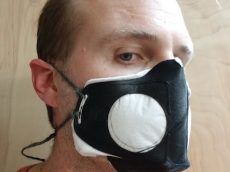
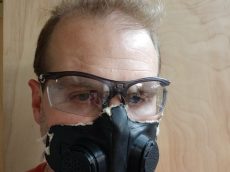











58 Comments
Beth Gordon
I created a video tutorial here for DIY fabric masks: https://www.instagram.com/p/B-PxhrYFtVN/
My goal was to make a guide on how to sew a lot of masks quickly with minimal sewing skills and minimal materials. Although it doesn’t offer the best protection, these are super quick to crank out so you can make a bunch and wash them between each use. In addition to being latex-free, an advantage of making 100% cotton masks (vs. ones with elastic) is that they can likely survive a steam autoclave. Wireless masks are also much safer to wash/sterilize repeatedly since you don’t have to remember to remove the wire when washing a bunch of masks at once.
Aaron alai
For those looking for literature on the efficacy of different materials for masks check out this paper https://www.cambridge.org/core/services/aop-cambridge-core/content/view/0921A05A69A9419C862FA2F35F819D55/S1935789313000438a.pdf/testing_the_efficacy_of_homemade_masks_would_they_protect_in_an_influenza_pandemic.pdf
Concerned
The Halyard H600 material is NOT full N-95 compliant. If you go to the mfg you’ll see it is tested only at the level of 3.0 microns as are disposable and surgical masks. An N95 mask is 10X more stringent at 0.3 microns. Please correct your info above.
Alex Nugent
Interesting. Their initial claim appears to be based on bacteria, not particle size:
“It blocks 99.9% of particulates, making the masks about 4% more effective at blocking particulate material than the N95 masks, according to Bruce Spiess, M.D., a professor of anesthesiology in the UF College of Medicine, who made that calculation based on the manufacturer’s specifications.”
Among the smallest bacteria are members of the genus Mycoplasma, which measure only 0.3 micrometres, as small as the largest viruses…and technically the N-95 specification.
Bacteria range in size from ~.2 microns to 5 microns. Among the smallest bacteria are members of the genus Mycoplasma, which measure 0.3 micrometres, as small as the largest viruses…and the same size as the N-95 specification. A very quick look into Bacterial Filtration Efficiency tests indicate the use of an aerosol of Staphylococcus, and a search for this species size yields ~.5 X 1.5 microns. So while the material has not been N-95 rated, it seems pretty darn good.
Will be interesting to see where this lands when somebody undoubtedly tests it in the next few days.
Best way to get to the truth quickly is to say something wrong on the internet!
Coyote
Thanks for your work.
I have a sleep mask like this one https://www.riptgear.com/product/sleep-mask
The covering part is approximately 17 cm*8cm
Do you think it is better than nothing?
Is there an easy way to upgrade it (for instance by adding a layer)?
Alex Nugent
I would recommend building or finding a mask intended to cover your mouth and nose. If you use this as a mouth covering, you may want to add an extra band/tie so that you have two–one on neck and one over ears. This will keep the mask over your face and prevent it from falling. May also want to flip it upside down so that soft flexible layer is pressed over your nose area for a better seal. Better than nothing, and being creative reduces stress.
Jacqueline Hall
Can you wash the Halyard H600 fabric?
Alex Nugent
No. Please see here for more guidance. To disinfect, bake it at 165F for 30 minutes. Also this is a good reference for sterilization procedures of N-95 masks.
Paul H
https://cv-masks.github.io/cotton_facemask_with_satin_liner_and_plastic_retainer-v6.1.1.pdf – this mask has two layers from only two pieces of fabric. It also has a cotton retainer for extra cupping to increase breathability as the satin layer’s high-filtration means it is normally hard to draw breath through
Emily Lawson
The info about the HK Mask is incorrect. It says the HK Mask needs a nose wire, but the pattern instructions say to use one already.
Alex Nugent
thanks for the comment, we have fixed it.
Joe Sloane
Hi Alex. I’m not a manufacturer but we have a hydraulic press that is used to punch paper and thin leather gaskets of various forms. If I made a steel rule die to punch masks and pass them on to an entity that could further the assembly process, would that be practical?
Alex Nugent
Im sure it would be, but we need to connect you with the right group. My first thought is cutting Halyard 600 forms for hospitals. This page is getting a lot of search traffic, so I will highlight this comment and perhaps somebody will see it.
Brent Courson
Maker Works in Ann Arbor, MI has developed a laser cut face shield that could be die cut from ABS plastic.
https://www.maker-works.com/helping-in-the-covid-19-crisis
Sammy
Hi Alex, thanks for compiling these. I just wanted to give you a heads up that the picture you included for the University of FL mask is for Prototype 1 and not Prototype 2 – so you might want to swap that out. I watched a video on testing these and it was super interesting! Heres the link to that youtube video: https://www.youtube.com/watch?v=DZBbkn-g-vE&list=PLQ4w6VTcd6noVqPbwBLaHHJi89ZjS5UNN&index=4&t=782s
Alex Nugent
Thank you for comment. I have included link to video and update the title.
Beckyjsc
Thank you so much for compiling this list – it is extremely helpful!!
Tammy
Can you use leather as an outer layer? how does it rank protection wise?
Alex Nugent
No. Leather will block airflow. If your mask seals properly and it’s made of leather you will suffocate. Air-permeable fabric is needed unless the leather only forms part of the mask (for example the ties or rims/edges). Two layers of tight weave pre-shrunk cotton is most recommended common household material if you cannot get access to specially materials like surgical masks. If you use leather then air will take the path of least resistance around, rather than through, the material. The result is then no protection at all.
Inger S Brodey
Here’s another option made with high quality HVAC filters!
https://youtu.be/Bvq8yZ__Ajw
Alex Nugent
Thank you, I have added this design to the list.
Eric Berg
This is a great list, with great comparisons of all the important aspects. Thanks for making it! I have one more 3D printed mask to add to the list:
https://youtu.be/X25sQwk8jro
It is based on Copper3D’s redesign of the NanoHack, and it makes a much better face seal with the use of weather stripping seal and a HEPA air filter for high protection. It is also very easy to clean since the filter, seal and straps can all be removed and replaced. I would appreciate it if you could add this to the list after doing your analysis. Thanks!
Charles vidal
A mask done with a part of bra: https://youtu.be/OeV9vDY5ilQ
Silvia
Great list with great information. I found this 2 diy masks. Do you think you can added to your list?
1) https://youtu.be/W6d3twpHwis
2) https://youtu.be/N8WSpnVSsRg
Thank you again for the info!
Denise
Love the mask with clear panel for people that need to lip read
Patience M Kerns
Are these activated carbon filters effective? The seem to be to purify air from chemical impurities but no info on the effectiveness against viruses
Alex Nugent
I would assume no.
Pamela A Mills
can you heat a cloth hepa filter vacuum bag 170 degrees for 30 minutes. I am using these as filters so they can be removed and the fabric mask washed so I’m looking to bake or microwave the filter to clean it?
Alex Nugent
I am not aware of any research on this, but my guess is that heating for 30 min at 170 degrees is OK. If the material itself can sustain the temperatures, then the virus should also have been deactivated. I am unaware of effectiveness of microwave other than to say I doubt virus or dry material will absorb microwave radiation–and you want to keep the material dry.
Kale
Image #1 shows the wrong mask. The mask shown is UHF prototype #1 and it did not pass the N95 fit test. the mask that passed is called prototype #2. They are quite different but also very easy to make. The h600 fabric is a fantastic material, sturdy, easy to work with. Thanks for your reviews!
Laura
How’s this mask? https://freesewing.org/docs/patterns/fu/
I’ve seen articles about using reusable bags as a filter (or similar fabric such as https://www.joann.com/olyfun-10-yard-bolt/zprd_14065353a.html). Is that at all effective?
Alex Nugent
I do not believe that material has undergone testing, however it is a non-woven polypropylene material so its not a bad choice. My guess is that it is at least as good as a cotton shirt if not better. In regards to the linked mask, it is OK. best designs will include a wire around the nose to improve the seal as well as a pocket for a filter. See “HK Mask”, for example. A tight-weave pre-shrunk cotton with filter inserts made of the Olyfun would be good. However, since the Olyfun has not been tested this should not be worn by medical professionals nor represented as anything other than an “untested DIY mask”.
Jason Bowling
I came up with a way to add a filter to a snorkel mask without special tools, machining, or a 3D printer. It appears to work well, though I have no way to clinically validate it. Build details here: https://medium.com/@kb8rnu/building-a-diy-full-face-filter-mask-6cf4a5ffaa3d
Valerie P
I’m going to be making an “Olson” style mask following an online tutorial. In the tutorial they said you can use double-sided adhesive tape that’s skin safe – to give a better seal of the mask around the face, but they didn’t mention what kind they used or recommend a brand..I’ve found double-sided body tape used for fashion, but they came in a small pack of strips, which wouldn’t last very long since I’m making the mask to wear to work each day, would you know of any kind/brand that comes in a roll? I considered trying just regular double-sided tape, but not sure if it would be ok to use on skin or if it would adhere to skin well enough.
Chen Lee
Any thoughts on using the thinner Halyard (H100) fabric as filter material in the filter pocket of cotton masks? Perhaps a double layer? H600 is difficult to come by…
Alex Nugent
In general multiple layers of material is actually better than a single layer of a ‘double weight’ fabric. My guess is that multiple layers of H100 is an excellent option. Searches for Bacterial Filtration Efficiency (BFE) of Halyard material result in claims of ~96% to 99.9%. My guess is that H100 is on the lower end. BFE is not the same as N95 particulate standards, which is .3 microns while BFE is 3 microns.
Jo Lang
Hi, can you speak to what constitutes a, “tea towel”, for clarification? and if you can improve filterability with two layers of say, cotton, what would 3 or 4 layers be? Thanks
Alex Nugent
A tea towel is another name for “Kitchen Towel” or “Dish Towel”. Adding two layers of dish towel does help, but adding more layers of other materials like cotton t-shirt only helps 1-2% (see this article). At some point, adding more layers will be counterproductive by making it too hard to breath. When this occurs, air can find its way around the mask through the edges, unless the mask has an amazing seal. At this point the masks usefulness is greatly deteriorated from the perspective of providing protection to the user.
Sara
Hi Alex,
I created a mega-list of 64 hospital-approved DIY face masks. I thought it might be a handy resource for your readers. All the info is directly from hospitals and the CDC.
Here’s the link: https://threadsmonthly.com/free-fabric-face-mask-sewing-patterns/ 🙂
JO
A recent study measured Covid at 20nm, at this point almost no fabric can filtrate and those that can rely on static electricity. Why not go directly with 100% waterproof material, and breathe through a loose fit like surgical and homemade masks?
Alex Nugent
While the virus is very small, its usually enveloped in droplets of mucus/saliva, so I think it would be incorrect to assume that larger filters could not offer some protection. Coating a fabric with virus-deactivating agents like salt could help. A loose fitted waterproof mask could provide some protection to others from you, which is a big part of DIY masks.
JODY MACK
Any opinion on the use of shop towels (https://www.youtube.com/watch?v=3QmIIrss-dc)? I made a mask today that was super easy and fit great.
Amy Flynn
I’d love to know about the protective qualities of the shop towels also. I have made the University of Florida Prototype 2 mask, which they make of Halyard 600, out of Wypall X80 shop towel. So it’s a double layer. Fits really well, easy to breathe in, but wonder if it’s any better than a cotton mask or surgical mask…
Desmond Hsiao
If cone shape drip coffee paper filters (mid size, for 2-4 cups) are available around, you can build this disposable mask with some more materials which are very easy to get. All you need is a stapler and a pair of scissors. No needle nor thread needed. Very easy to make, just staple 2pcs. of paper filters together along the curve, and seal the curve with surgical tape.
Linda Parkins
The Hepa vac bags were tested? Manufacturer has warned not to use them as asbestos may be present. Why was this not mentioned? In addition, there are different fabrics used for kitchen towels; the flour sack is tightly woven, would work well if doubled. Then terry/terry towel would absorb moisture as it’s designed to. Looped toweling is useless.
Finally, the thread matters. Cheap thread will not last, plus polyester & poly-cotton would not be advisable. Anyone who sews also knows to use sharp needles in their machines, the same should be used for any pins used for pleats, etc. Change them often, use the correct size. Every time time the needle punctures the fabric, more holes are created. In my opinion, the seam down the front of the face is less protection. It’s not a fashion statement, it’s for protection. Thank you for taking the time to help others. I am high risk, rarely leave the house here in Washington state. Stay safe!!
Alex Nugent
Can you provide a link to the Manufacterer information as well as the project name/mask you are referring to? A number of masks use hepa material.
Graham Rankin
I have a ‘Frame Mask’ design I would like to contribute to your site. It uses moisture-resistant recycled aluminised Tetra Pak carton for the mask shape, and separate wire for the surrounding frame, so it can offer a choice of filter materials in the middle, which can then be quickly replaced. There’s also a Google docs template for downloading.
Thanks for your consideration!
https://www.youtube.com/watch?v=G2J1NGx_BiQ
Lon Britton
Rather than the percentage of effectiveness, I would like to see what the smallest particle size each material will filter, say as in microns. This was given for the Halyard 6000 at 3.0 microns. It is my understanding that COVID-19 is 0.1 micron in diameter. If that is true then it doesn’t sound like any of these materials would be effective in filtering COVID-19. In that event what would be the point of wearing any mask made of the above materials (other than better safe than sorry)? I did see your comment to Jo “usually enveloped in droplets of mucus/saliva…”. What size is a combination of COVID-19 and mucus/saliva? Also, when would the virus not be combined with mucus/saliva? Do you know where I can find filter ratings for particle size filtered (in microns) for various materials?
Mar max
Get an eye mask used for sleeping. Turn up side down. Put over head as usual but pull down over nose and mouth. Many even have a little snip of cloth that you put over the tip of nose for a tighter fit. (Patented idea here) voila!
Jillian
Have you seen this tutorial by My Pocket Pediatrician? She’s done a lot of research on different filters and has fit tested her final/updated design.
https://youtu.be/2J3Fq4o-U4I
Dale Jacobson
I think I have a better easy and efficient no sew blue shop towel mask the seals really well and is quick to make.
https://www.youtube.com/watch?v=ZmV6OpmlnRQ&t=34s
Mina
There is one creative and quite extraordinary looking face mask pattern. It mixes crochet and sewing, but it is also possible to disifect it by boiling in hot water.
https://issuu.com/nocturnalbird/docs/jiki_crochet_mask_frame_pattern_en_1.2b
Ed Fisher
See video demo for DIY mask and snorkel respirator for guys with facial hair at https://vimeo.com/409189700
Varun Jagetia
Loved your post! Vital information for living in the new “normal”
With the new information provided by WHO, stating that the COVID-19 virus could be airborne in certain conditions, wearing facemasks at all times is now essential for personal safety and the safety of others.
Cotton facemasks are the most comfortable option during these times. They are skin-friendly, reusable, and can be comfortably worn for long durations.
Melissa Coleman
How effective to you feel this mask would be? If combined with a face shield? It’s primarily made from vinyl. Trying to find something that is clear so I can still communicate with a deaf relative.
Alex Nugent
It’s better than nothing and obviously intended to solve a difficult problem. Vinyl is not permeable to air, which means the air will be redirected out the perimeter of the mask instead of through the fabric. In other words it does not have a good seal, and cant, because if it did the user would suffocate. If the purpose is transparency, the glitter should go.
AMINE
Hello,
If will be great if you can test our mask as well.
https://www.thingiverse.com/thing:4249825
http://www.amaskforall.com
thank you
V
Wow what a useful article! Thanks for sahring! About surgical mask making machine</ a> , this machine looks good in mask production.